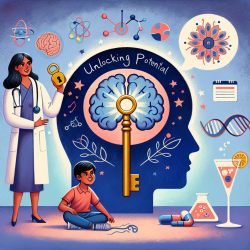Understanding NAXE-Related Disease: A New Frontier in Speech-Language Pathology
In the world of speech-language pathology, staying abreast of the latest research is crucial for providing the best outcomes for children. The recent case report titled Long-term follow-up of an attenuated presentation of NAXE-related disease, a potentially actionable neurometabolic disease: a case report offers valuable insights into a rare neurometabolic disorder that can inform and enhance therapeutic approaches.
What is NAXE-Related Disease?
NAXE-related disease is a neurometabolic disorder caused by mutations in the NAXE gene, which affects the body's ability to repair certain metabolites crucial for cellular energy processes. This condition often presents with neurological symptoms that can severely impact a child's development, including speech and language skills.
Key Findings from the Case Report
The case report follows a 24-year-old patient with a milder form of NAXE-related disease. Despite early neurological challenges, the patient showed significant improvement and stabilization with a treatment regimen that included a mitochondrial cocktail and niacin supplementation. This case highlights the potential for therapeutic interventions to mitigate the progression of symptoms.
Implications for Speech-Language Pathologists
For practitioners, this research underscores the importance of a multidisciplinary approach in managing complex disorders. Here are some key takeaways for speech-language pathologists:
- Early Intervention: Recognizing symptoms early and collaborating with medical professionals can lead to timely interventions that may improve outcomes.
- Customized Therapy Plans: Understanding the underlying genetic and metabolic factors can help tailor therapy plans to address specific needs, such as motor planning and coordination, which are often affected in neurometabolic disorders.
- Monitoring and Adaptation: Regular assessment and adaptation of therapy strategies are essential, as the child's needs may change over time, especially with the introduction of new medical treatments.
Encouraging Further Research
This case report opens the door for further research into the role of metabolic and genetic factors in speech and language development. Speech-language pathologists are encouraged to collaborate with researchers and medical professionals to explore new treatment avenues and improve therapeutic outcomes.
Conclusion
Understanding NAXE-related disease and its impact on child development is a step forward in creating more effective, data-driven therapy plans. By integrating these insights into practice, speech-language pathologists can better support children with complex needs, ultimately enhancing their communication skills and quality of life.
To read the original research paper, please follow this link: Long-term follow-up of an attenuated presentation of NAXE-related disease, a potentially actionable neurometabolic disease: a case report.










